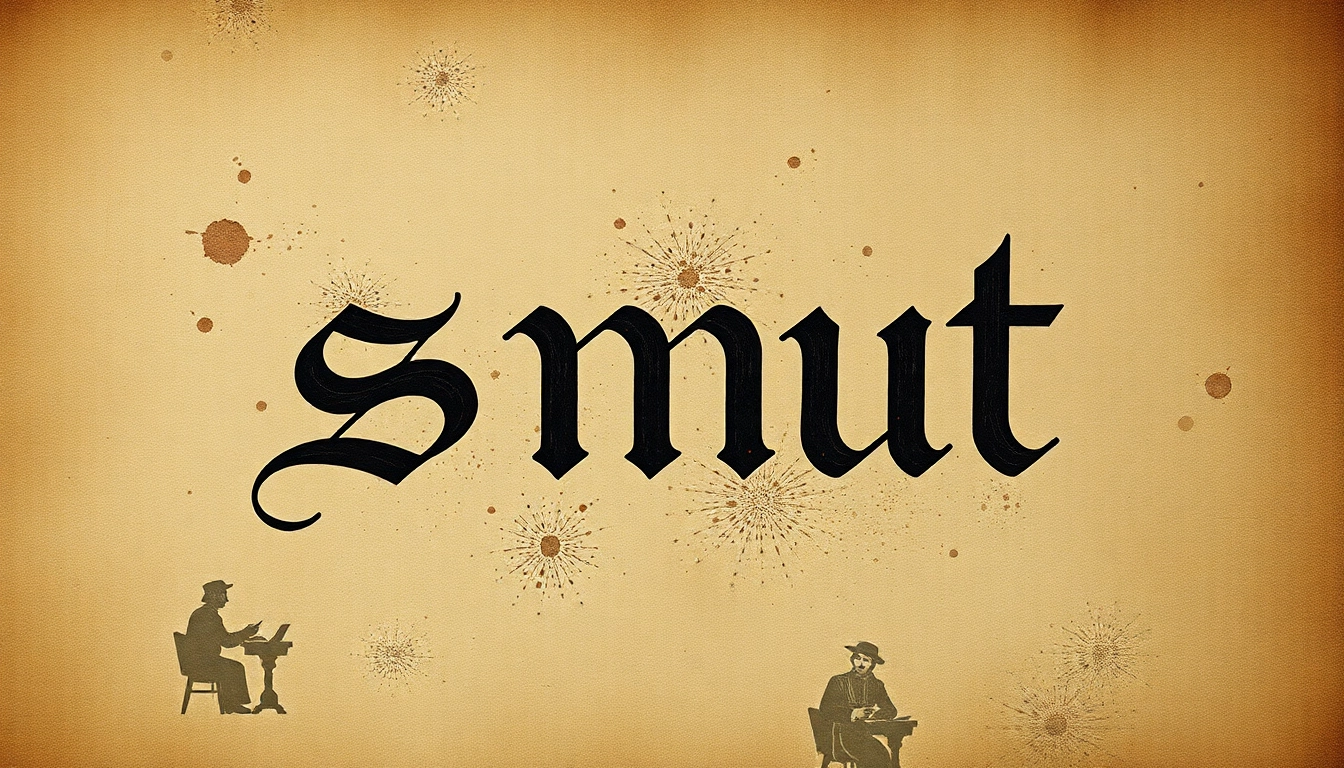Introduction: Defining Smut in Modern Context
The term smut has become an integral part of contemporary discussions surrounding adult media, literature, and art. Today, it is commonly associated with explicit content designed to evoke arousal, emphasizing sexuality and adult themes. Whether in movies, literature, or visual art, smut is characterized by its intent to stimulate sexual desire and challenge societal taboos. However, the journey of this word from its origins to its current usage is complex, layered with historical shifts, societal influences, and cultural debates. Understanding what smut signifies today requires exploring its etymology, historical context, and evolving connotations over centuries.
The Historical Origins of the Word “Smut”
Etymology and Early Usage as Dirt or Stain
The earliest records of the word “smut” date back to the 17th century, where it primarily referred to dirt, soot, or stains—particularly on clothing, surfaces, or even on the skin. This initial meaning was straightforward, describing physical impurities or blemishes that marred cleanliness or purity. The word itself is believed to have roots in Old English and possibly other Germanic languages, with similar words existing across Europe that denote dirt or filth.
In this early context, “smut” was a neutral, descriptive term used in everyday language, often associated with dirt accumulated from soot, smoke, or mud. It was used literally and practically, with no connotations of morality or indecency attached to it. For example, sailors and laborers would mention “smut” when describing soot on their clothes or grime on their hands. The focus was on physical stain rather than moral or social judgment.
The 17th-century References
In the 17th century, the term continued to be used in its literal sense. Literature and records from this period occasionally mention “smut” in descriptions of dirty environments or clothing. Despite its physical connotations, the word also began to acquire metaphorical meanings, suggesting moral impurity or corruption in certain contexts. However, these figurative uses were still not dominant, and “smut” remained primarily associated with dirt.
Interestingly, the transition from a purely physical description to a more metaphorical or moral sense was gradual. Writers of the time sometimes used “smut” to refer to morally corrupt behaviors or speech, but these references were limited and context-dependent. The predominant understanding remained rooted in physical dirt and filth, with moral implications only occasionally emerging in literary usage.
Transition to a Term for Obscene Material
19th-century Shift in Meaning
The pivotal shift in the meaning of “smut” from dirt to obscene material occurred during the 19th century. During this period, societal attitudes toward sexuality, morality, and censorship became more rigid, especially in Western countries. As a result, the word “smut” evolved from describing physical filth to denoting indecent, obscene, or morally corrupt content.
This change was influenced by the Victorian era’s emphasis on morality and propriety, which led to a heightened sensitivity to anything considered scandalous or immoral. Literature, art, and media that depicted or implied sexuality often faced censorship, and “smut” became a catch-all term for material deemed inappropriate or scandalous.
The association of “smut” with immoral content was reinforced by the rise of printing presses and the proliferation of inexpensive books, newspapers, and pamphlets that sometimes included risqué material. These publications were often targeted by authorities and moral watchdog groups, who labeled them as “smut” to underscore their indecency and to justify censorship efforts.
Cultural and Societal Influences
Several cultural shifts contributed to the evolving meaning of “smut.” The 19th century saw the rise of moral reform movements and censorship laws designed to protect public morality. Authorities and religious groups often equated obscenity with moral decay, and “smut” became a potent term used to stigmatize and suppress certain types of media.
Literary works that challenged Victorian sensibilities, such as the infamous novel “Fanny Hill” by John Cleland, published in 1748 but widely circulated and censored in the 19th century, exemplify this transition. “Fanny Hill” was considered scandalous and was often banned or heavily censored, with “smut” becoming a descriptor for its explicit content.
At the societal level, the term’s association with scandal and morality meant that “smut” was not merely a descriptor but also a moral judgment. It served as a linguistic tool to condemn and regulate media that pushed the boundaries of accepted propriety.
Notable Historical Examples
Fanny Hill and Censorship
“Fanny Hill,” officially titled Memoirs of a Woman of Pleasure, is one of the most famous examples of early erotic literature that faced censorship and controversy. Written by John Cleland in 1748, the book was initially penned by Cleland during his imprisonment. Its explicit descriptions of sexual adventures challenged societal norms and provoked outrage from moralists and authorities.
Despite its scandalous reputation, “Fanny Hill” has become a literary classic and a symbol of early erotic literature. Throughout the 18th and 19th centuries, it was heavily censored, banned in many countries, and considered “smut” by authorities intent on moral preservation. The book’s notoriety helped cement the association of “smut” with sexually explicit material.
The controversy surrounding “Fanny Hill” illustrates how societal perceptions of morality and decency influenced language. Its repeated bans and censorship efforts reflected broader societal anxieties about sexuality, morality, and the boundaries of acceptable expression.
Literature and Media in Changing Eras
Beyond “Fanny Hill,” many other works of literature, art, and media have contributed to the evolving concept of smut. In the Victorian era, the rise of sensationalist newspapers and underground publications often contained explicit descriptions or illustrations that were considered scandalous. These publications were often labeled as “smut” to discredit or censor them.
Throughout the 20th century, the advent of cinema, photography, and later, digital media, expanded the scope of what could be considered smut. Films and magazines that depicted explicit sexual content often faced legal and societal challenges, with the term “smut” being used to describe such material, especially when it was considered morally objectionable or illegal to distribute.
In contemporary times, the line between acceptable adult content and smut continues to be debated, with legal standards, cultural norms, and personal preferences shaping the definition and perception of what constitutes smut in various societies.
Modern Usage and Connotations
Media, Art, and Literature Today
Today, “smut” is predominantly associated with explicit media intended for adult audiences. It encompasses a broad spectrum of content, including erotic literature, adult films, visual arts, and online material. The term often carries a slightly pejorative or stigmatizing connotation, especially in conservative circles, where it is used to criticize or censor such material.
However, in more liberal or open-minded contexts, smut is recognized as a legitimate form of artistic expression and sexual exploration. The proliferation of the internet has democratized access to adult content, blurring traditional boundaries and challenging societal notions of decency. Many artists, writers, and filmmakers now produce and distribute explicit material that might once have been labeled as “smut,” but is now viewed as a form of free expression or adult entertainment.
In literature, genres such as erotica and erotic romance have gained popularity, often straddling the line between artistic storytelling and explicit content. Similarly, adult film industries produce content that is both commercially successful and culturally influential, though often still subjected to censorship and societal critique.
The Role of Smut in Adult Entertainment
In the realm of adult entertainment, smut plays a significant role by providing visual and narrative stimulation for consenting adults. It serves both commercial purposes and personal exploration, often pushing societal boundaries and challenging taboos about sexuality.
Despite its widespread acceptance in many circles, the term “smut” remains controversial, especially among conservative groups or in legal debates about obscenity laws. The portrayal of explicit material as “smut” often implies moral judgment, which fuels ongoing debates about freedom of expression, censorship, and the regulation of adult content.
Nevertheless, the demand for adult content continues to grow, and the conversation around smut’s role in society reflects broader discussions about sexuality, morality, and personal freedom.
Cultural Significance and Controversies
Taboo, Censorship, and Freedom of Expression
The cultural significance of “smut” is deeply intertwined with societal notions of morality, decency, and censorship. Historically, societies have fluctuated between permissiveness and repression regarding explicit content. While some cultures embrace sexual expression openly, others impose strict censorship laws, often branding explicit material as “smut” to stigmatize and control it.
In many countries, legal battles over what constitutes obscenity continue to influence the availability and perception of smut. These debates often pit arguments for freedom of expression against moral and social concerns. The legal standards for defining and regulating smut vary widely, with some jurisdictions adopting lenient policies and others enforcing strict bans.
Historical examples include the Comstock Laws in the United States, which criminalized the distribution of obscene materials, including what was then considered smut. These laws reflected societal anxieties about sexuality and morality, and their legacy persists in ongoing discussions about censorship and personal rights.
Controversies also arise around the exploitation and objectification within some adult media, raising ethical questions about the production and consumption of what might be labeled as smut. These debates highlight the tension between personal freedom and societal responsibility.
Conclusion: The Changing Face of Smut / The Evolution of Smut: From Dirt to Desire — A Historical Perspective
The journey of the word smut from its humble origins as a descriptor of dirt and stains to its modern connotation as adult, explicit media reflects broader societal changes. It encapsulates shifting attitudes toward sexuality, morality, censorship, and artistic expression. What once signified physical filth has metamorphosed into a term loaded with moral judgments, controversy, and cultural significance.
Understanding the evolution of smut offers insight into how societies negotiate the boundaries of decency, the importance of personal freedom, and the enduring power of language to reflect societal values. As cultural norms continue to evolve and technology advances, the concept of smut will undoubtedly adapt further, challenging existing definitions and perceptions.
In embracing this complex history, we recognize that what was once considered mere dirt or stain now serves as a symbol of desire, rebellion, and expression. The history of smut underscores the importance of contextual understanding and the ongoing dialogue about morality, censorship, and individual rights in shaping societal attitudes towards adult media and art.









